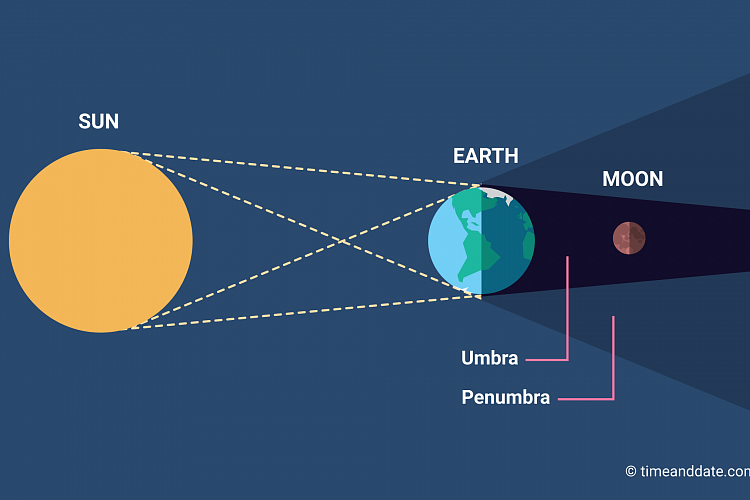Here is How/When to see the Lunar Eclipse in the Southern MN Area


A total lunar eclipse takes place when the Earth comes between the Sun and the Moon and covers the Moon with its shadow. When this happens, the Moon can turn red, earning it the nickname of Blood Moon.

Earth casting its shadow on the Moon. timeanddate.com
Paired Together
Total eclipses of the Moon happen at Full Moon when the Sun, Earth, and Moon are aligned to form a line. The astronomical term for this type of alignment is syzygy, which comes from the Greek word for being paired together.
Earth Blocks the Sunlight
The Moon does not have its own light but shines because its surface reflects the Sun’s rays. During a total lunar eclipse, the Earth comes between the Sun and the Moon and blocks any direct sunlight from reaching the Moon. The Sun casts the Earth’s shadow on the Moon’s surface.
Earth’s Three Shadows
Earth’s shadow can be divided into three parts:
- Umbra – the darker, central part.
- Penumbra – the outer part.
- Antumbra – the partly shaded area beyond the umbra.
During a total lunar eclipse, Earth’s umbra completely covers the Moon.
Sun, Earth, and Moon Aligned
For a lunar eclipse to occur, the Sun, Earth, and Moon must be roughly aligned in a line. Otherwise, the Earth cannot cast a shadow on the Moon’s surface and an eclipse cannot take place.
When the Sun, Earth, and Moon come together in a straight line, a total lunar eclipse takes place. When the three bodies are aligned in a way that the Moon is partly covered by the Earth’s umbra, a partial lunar eclipse is a result. On the other hand, if only the outer part of Earth’s shadow covers the Moon, a penumbral lunar eclipse takes place.
Earth’s umbra extends into space far beyond the orbit of the moon. This means that Earth’s antumbra plays no role in lunar eclipses.
Only at Full Moon
Total lunar eclipses happen only when:
- The Sun, Earth, and Moon are in a straight line,
- and there is a Full Moon.
Why don’t we see a lunar eclipse every month if a Full Moon is needed for a total lunar eclipse?
This is because the plane of the Moon’s orbital path around Earth is inclined at an angle of 5° to Earth’s orbital plane around the Sun, also known as the ecliptic. The points where the two orbital planes meet are called lunar nodes. Lunar eclipses occur when a Full Moon happens near a lunar node.






